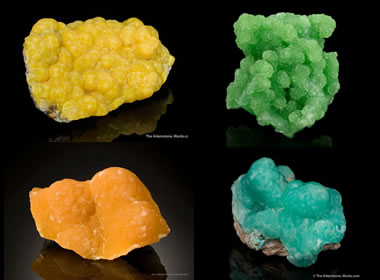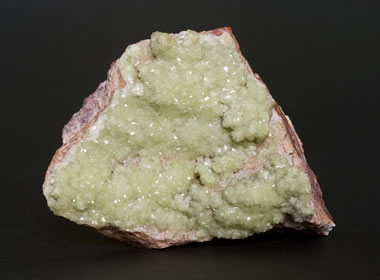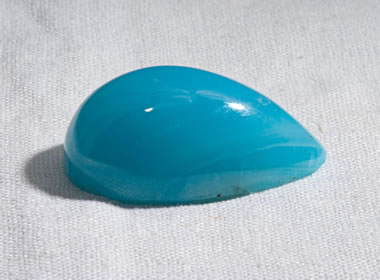
Smithsonite Colors: Smithsonite specimens in spectacular colors are popular with mineral collectors. Clockwise from top left: a yellow cadmian smithsonite with a botryoidal habit from Arkansas, 6.6 x 4.4 x 2.8 cm.; a green cuprian smithsonite from Namibia, 3.9 x 3.3 x 2.9 cm.; a greenish blue specimen from the Kelly Mine, New Mexico, 8 x 5.8 x 4.5 cm.; an orange cadmian smithsonite from Mexico, 10.1 x 7 x 5.5 cm. Specimens and photos by Arkenstone / www.iRocks.com.
What is Smithsonite?
Smithsonite is a zinc carbonate mineral with a chemical composition of ZnCO3. Today it is a minor ore of zinc, but in the early days of metallurgy it was one of the most important ores. Typical smithsonite colors are brown, gray, white, green, and yellow. Translucent specimens in vibrant blue, green, pink, and yellow colors are favorites of mineral collectors. Smithsonite is also cut into collector gems and used as an ornamental stone.
Table of Contents
 What is Smithsonite? What is Smithsonite? Geologic Occurrence Geologic Occurrence Smithsonite vs. Hemimorphite Smithsonite vs. Hemimorphite Smithsonite Gemology Smithsonite Gemology |

Smithsonite Crystals: Smithsonite is almost never seen as well-formed crystals. This specimen, from Namibia, is a piece of country rock covered with a druse of grayish green crystals. Image copyright iStockphoto / MarcelC.

Dry-Bone Ore: An impure and friable variety of smithsonite with a honeycomb-like structure is known as dry-bone ore. It is a secondary mineral found where zinc deposits have been oxidized. Image copyright iStockphoto / BrankoBG.
Geologic Occurrence
Smithsonite is a secondary mineral found in the rocks above and around many important zinc deposits. These smithsonite occurrences are often seen at the surface or at shallow depths. As a result, smithsonite was one of the earliest zinc minerals to be discovered and mined by pioneer metallurgists. Finding smithsonite at the surface has led to the discovery of a major zinc deposit below.
Much smithsonite originates when weathering liberates zinc from a deposit's primary mineral - which is often sphalerite. Zinc ore oxidized in the presence of carbon dioxide can result in the formation of smithsonite. This smithsonite is a secondary mineral often found as fracture fillings and botryoidal coatings on country rock. Smithsonite, formed from redeposited zinc, is an excellent example of a secondary mineral.
Smithsonite is almost never found as nice crystals. Botryoidal coatings on rocks and fractures are a common mode of occurrence. Another mode of occurrence is known as dry-bone ore - an impure and friable variety of smithsonite with a honeycomb-like structure.
Physical Properties of Smithsonite |
|
| Chemical Classification | Carbonate |
| Color | Usually brown or gray, but may be colorless, white, yellow, green, blue or pink. The colors can be spectacular, and that makes smithsonite popular with people who collect mineral specimens and gems. |
| Streak | White |
| Luster | Vitreous to pearly |
| Diaphaneity | Translucent |
| Cleavage | Perfect rhombohedral cleavage. Uneven to conchoidal fracture. |
| Mohs Hardness | 4 to 4 1/2 |
| Specific Gravity | 4.3 to 4.5 |
| Diagnostic Properties | Effervesces with cold, dilute hydrochloric acid (5% to 10%), high specific gravity, low hardness. Cleavage is similar to calcite. Botryoidal habit. |
| Chemical Composition | ZnCO3 |
| Crystal System | Trigonal |
| Uses | An ore of zinc. Specimens are popular with mineral collectors. Sometimes cut into gems for collectors. |
Smithsonite vs. Hemimorphite
Smithsonite and hemimorphite are two very different minerals. Smithsonite is a carbonate mineral and a member of the trigonal crystal system, while hemimorphite is a silicate mineral and orthorhombic. They also have noticeable differences in specific gravity and cleavage.
Even with these differences, the two minerals were confused with one another and identified by the name "calamine" until the mid- to late-1800s. An important contributor to this confusion is the fact that they were both often microcrystalline, translucent, and often intergrown with one another in a botryoidal crystal habit. As a result they were long thought to be the same mineral.
Investigators who know a few basic properties of these minerals and have the needed tools can easily identify them in monomineralic specimens. Identifying the mixture is more challenging. Use these properties:
- Smithsonite will effervesce under a drop of cold, dilute hydrochloric acid, but hemimorphite will not.
- Hemimorphite has a lower specific gravity (3.4 to 3.5) than smithsonite (4.3 to 4.5).
- Hemimorphite has perfect cleavage in one direction, but smithsonite has perfect cleavage in two directions that meet to form rhombic angles.
- Mixtures of these minerals will have an intermediate specific gravity and will react with cold, dilute hydrochloric acid.

Faceted Smithsonite: A step-cut oval gemstone, faceted from translucent yellow smithsonite. With a hardness of 4.5, smithsonite is too soft for most jewelry uses, but the mineral is cut into colorful gems for collectors. Image by SBS Eclectic Images / Alamy.

Smithsonite Cabochon: A teardrop-shaped cabochon, cut from bright blue smithsonite. With a hardness of 4.5, smithsonite is too soft for most jewelry uses, but the mineral is cut into colorful gems for collectors. Image by SBS Eclectic Images / Alamy.
Smithsonite Gemology
Smithsonite with excellent color and clarity is often cut into faceted gems and cabochons. It is rarely used in jewelry because it has a Mohs hardness of only 4 to 4.5 and would be quickly scratched and abraded even with careful wear. The accompanying photos show a faceted oval of translucent yellow smithsonite and a teardrop-shaped cabochon cut from translucent blue smithsonite.
Smithsonite is a good example of a collector's gem. They often have spectacular beauty but are too fragile to be practical in jewelry. They might also be extremely rare or not well enough known to have a viable market with jewelry buyers.
| More Minerals |
 |
Herkimer Diamonds |
 |
The Acid Test |
 |
Tumbled Stones |
 |
Zircon |
 |
Fool*s Gold |
 |
Kyanite |
 |
Rock Tumblers |
 |
Rhodochrosite |

Find Other Topics on Geology.com:

|

| ||

|

| ||

|

| ||

|

|
